Picture a scene that’s synonymous with the climate crisis.
Maybe your mind jumped to the Amazon rainforest or the polar ice caps, where deforestation and rapid melting have long been rallying points for conservation efforts.
But the latest research suggests it’s oceans that are key to tempering climate change. In fact, a microorganism you’ve probably never heard of captures 40 percent of Earth’s carbon emissions and produces oxygen for two out of every three breaths you take. These microscopic algae are called phytoplankton. It’s both the cornerstone of the marine ecosystem and a highly effective carbon capture system.
Phytoplankton depends on a steady supply of nutrients, including phosphorus, iron, and nitrogen. Fortunately, right at the top of the ocean food chain lives an incredibly efficient fertilizing machine: the whale.
Scientists have recently discovered that baleen whales eat far more than previously thought; the scale of their role as ocean fertilizers has been vastly underestimated. A 2019 study projected that if whales return to population levels they enjoyed before the era of commercial whaling, it would lead to a boom in phytoplankton and a staggering amount of carbon sequestering activity.
The bottom line? Nature has already perfected carbon capture. We just need to let whales eat, fertilize, and repeat.
Commercial whaling is all but over - in fact, conservation groups are using drones to gather evidence of illegal poaching. But these animals still face danger and disruption from fishing nets, ship strikes, and noise pollution. In order to put in place effective measures that conserve and encourage population recovery, scientists need to gather evidence to understand the full impact of human activity.
“Healthy Whales, Healthy Oceans, Healthy Humans”
That’s the motto of Ocean Alliance, a marine conservation organization pioneering the use of drones in whale research.
The relationship between DJI and Massachusetts-based Ocean Alliance goes back to 2015, when CEO Dr Iain Kerr and his team began using drones to collect biological samples from whales. Instead of taking an invasive physical biopsy, the researchers wait for the mammal to surface before flying a Petri dish-laden DJI Inspire through its blow - a cloud of exhalation that provides insights into the mammal’s hormones, DNA, and habitat. Naturally, they named the concept SnotBot®.
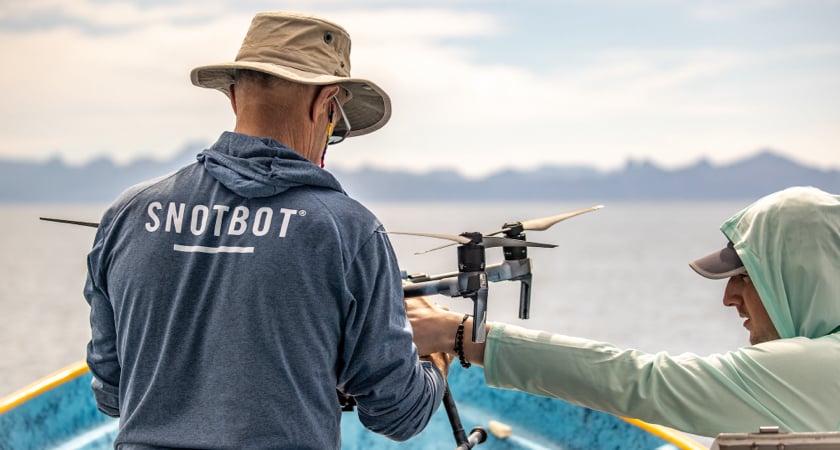
SnotBot was the answer to a question that’s faced whale researchers for decades: How do you gather decent whale data without chasing the animals in a boat and shooting them with a biopsy dart? (A method Kerr has described as the “world’s most expensive game of whack-a-mole.”)
But biological data only tells part of the story. To better understand whale behavior researchers need to observe their movements. No mean feat for animals that spend more than 80% of their time beneath the surface.
This year, Ocean Alliance has developed and tested a new data collection aid that could once again revolutionize the work of whale researchers. Just like with SnotBot, the solution uses an adapted DJI drone to avoid an expensive, dangerous, and stressful game of whale whack-a-mole.
A non-invasive way to tag whales
For decades, marine scientists have used data tags to track whales underwater. One common type of tag is fixed using suction cups and can carry a range of sensors - including a hydrophone, an accelerometer, and a camera. The data these tags collect provides researchers with insights into a whale’s hunting patterns, kinetics, acoustics, and even social interactions.
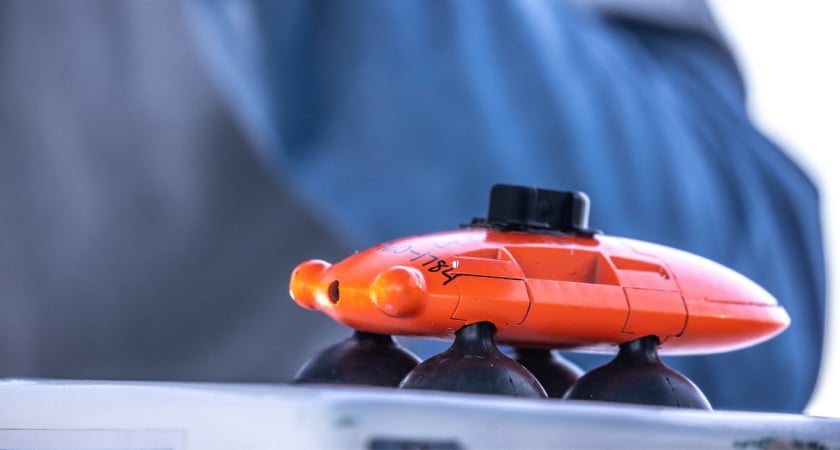
Just as with the collection of biological samples, tagging has traditionally been a dangerous and costly process. A team of experienced scientists across multiple vessels will spend countless hours chasing whales. It’s inefficient at best.
With the help of drones, things can be different. On an expedition in the Gulf of California in February 2022, Ocean Alliance became the first team in the world to successfully use flying robots to revolutionize the tagging process. The innovation could have huge implications for whale science and marine conservation more broadly.
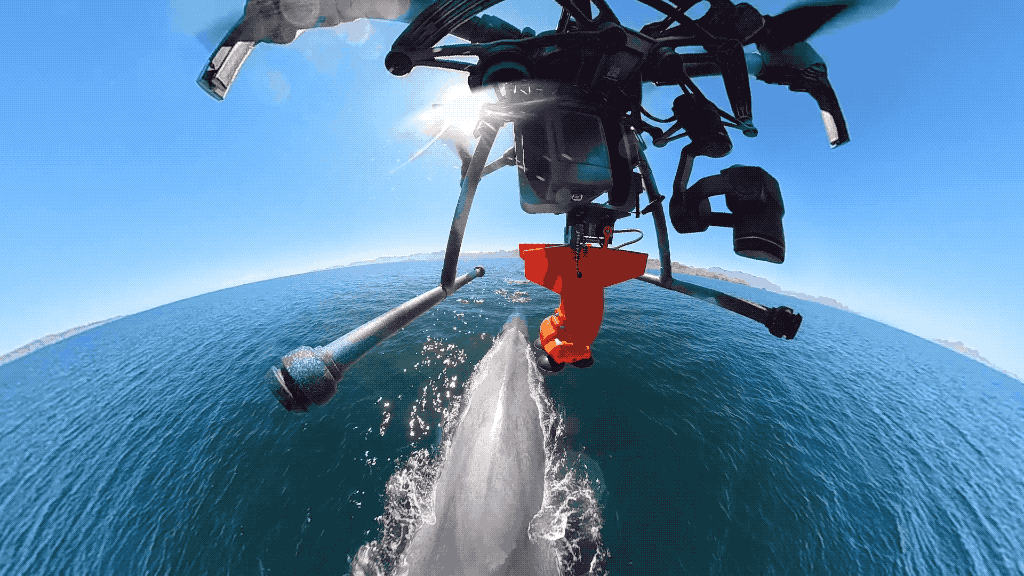
The Ocean Alliance team used modified DJI M210s to drop suction cup tags on Blue and Fin whales. There was no chase, no close approach, and no 20ft pole. Only successfully placed tags on more than twenty whales - many of which were 500m from the boat. They even had a 100% success rate with Fin whales, dubbed ‘the greyhounds of the ocean’.
“You don’t expect the first time you try something like this to keep hitting home runs,” says Kerr. But that’s exactly what happened.
Dr. David Wiley from NOAA’s Stellwagen Bank National Marine Sanctuary was a partner on the project and saw the new technique in action.
“It’s a game-changer for whales, people, and science,” he says. “In the 25 years I’ve been tagging whales, we have always dreamed of being able to place tags on animals from the air. The real-time aerial perspective allows whales to be followed underwater and researchers to be in position when they surface to quickly attach tags to them.”
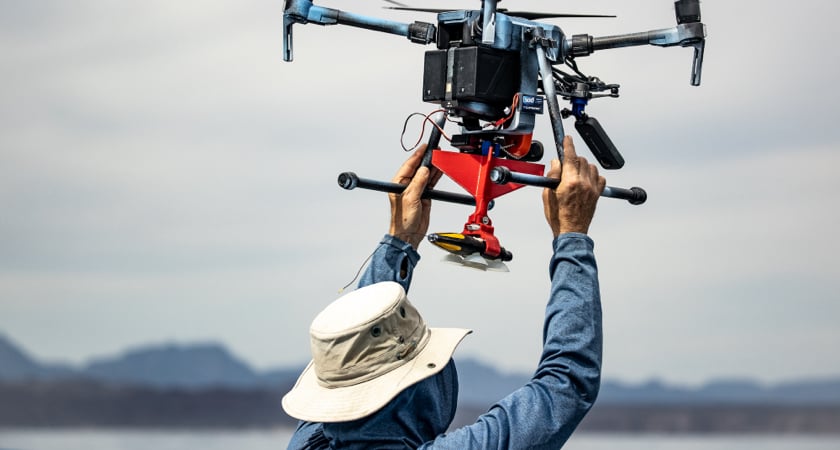
This success shouldn’t come as a complete surprise. The Ocean Alliance drone program, led by engineer, lead pilot, and whale snot collector-in-chief Chris Zadra, is now well established. No other team in the world has this much experience piloting drones above whales.
He explains that each tag drop follows the classic SnotBot approach, flying in behind the whale as it’s about to exhale. When the animal’s back arches above the surface, the tag is released by the pilot. It’s kept upright during the descent with the addition of some 3D-printed attachments. Once the device is in place, the pressure induced by the whale’s dive ensures it’s secure. The tags are released with fixed timing mechanisms that allow the researchers to track and collect them a predetermined number of hours later.
Not only is this new solution non-invasive and relatively stress-free for all involved, it’s smarter, faster, and cheaper than the traditional approach. Kerr believes it will be a gamechanger in parts of the world where there are whale populations researchers have never been able to get close to, such as Iceland and Madagascar.
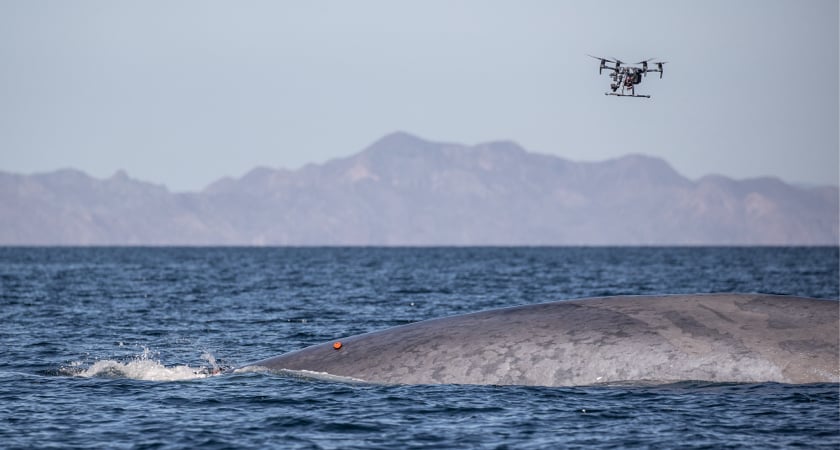
Developing a tagging solution
A key Ocean Alliance aim is to democratize access to whale conservation efforts. That means devising cheaper, more accessible solutions and sharing those with the wider research community.
“There are a couple of things we look at when deciding what idea to pursue,” explains Zadra. “We’re not a big engineering firm, so the first thing is that it needs to be simple. Then we look at what tech is available. Ideally, we’re taking something off the shelf, modifying it, and using it in a way to accomplish whatever goal we’re aiming for. Every drone solution is meant to make a current form of marine mammal research either easier, cheaper or more accessible. Tagging was a perfect combination of all that.”
The development process started in August 2021, when a conversation between David Wiley from NOAA and Iain Kerr turned a long-held ambition into a viable next project. OceanX agreed to fund the development process and the team got to work.
Although a drone was always going to be central to the solution, the exact method of tag attachment was up for debate. “We had half a dozen ideas that we wanted to try, but we started with the most simple: just dropping the tag,” says Kerr.
Typically solutions like this become more complex with each iteration. But the method and equipment required actually simplified as time went on. Students from the University of Michigan were tasked with calculating the amount of pressure needed; the force of the drop and the weight of the tag proved enough to hold the suction cups in place. Zadra prototyped a frame and a range of 3D-printed attachments to ensure the tags fell at the right angle.
 3D-printed attachments keep the data tags horizontal as they drop. The tags are released by a radio-controlled pin mechanism that sits on the underside of a DJI M210.
3D-printed attachments keep the data tags horizontal as they drop. The tags are released by a radio-controlled pin mechanism that sits on the underside of a DJI M210.
After successful testing at Ocean Alliance headquarters, the team rented out a nearby warehouse to try the solution on a moving target. Ballistic gel was used to mimic the body of Walter (the wannabe whale).
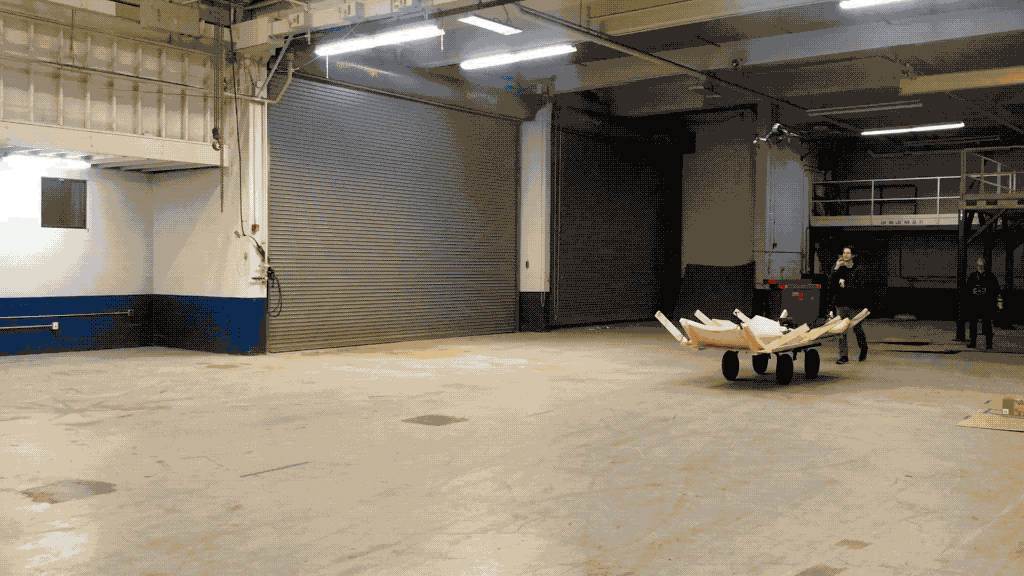
Over 200 test flights later the concept was ready for the real thing. In late February 2022, the Ocean Alliance team left for Mexico to test the new tag deployment technique in the wild.
A budget-friendly flying research vessel
When you’re studying whales, special permits and permissions are required. When you’re testing new ways to study whales, there are even more complications.
It’s here that drone technology offers priceless capabilities. In theory, the DJI M210 can track a whale, collect its snot, drop a tag, document the process, and film the animal’s reaction (or lack of) with its onboard cameras. It’s a flying research vessel that provides not just groundbreaking research capabilities, but a way to verify those capabilities and assess their impact.
A case in point is the footage Ocean Alliance gathered while dropping tags on whales in the Gulf of California. The team is still in the process of analyzing the footage from the test drops, but from their small sample the whales showed no detectable response to being tagged. And that’s empirical evidence that can be shared with the relevant authorities, rather than an account of what happened.
The aerial perspective also provides insights that would otherwise be missed. “From a boat, it can just look like a whale doing whale things,” says Zadra. “But from the drone you can see all of these tiny behaviors that you wouldn’t otherwise recognize.” These range from the raising of a fin to a burst of deceptive speed.
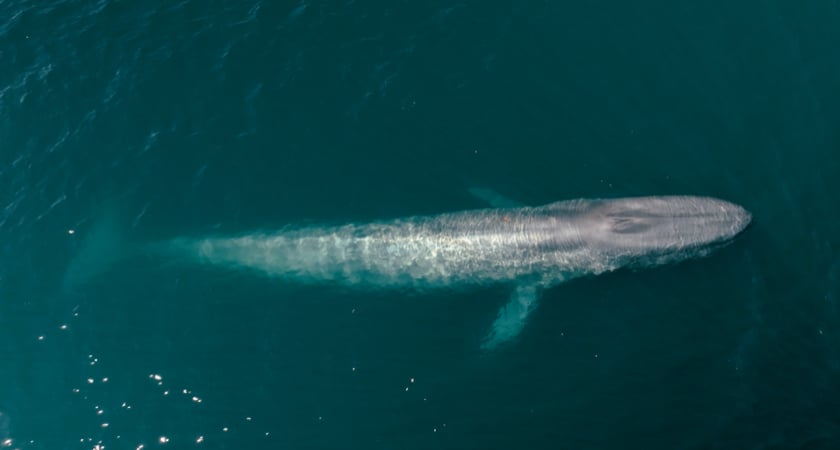
There are financial benefits, too. One of the most significant barriers for marine researchers is cost. Tagging expeditions typically require tens of thousands of dollars in funding - in part because several boats and a large team of international experts are needed. Using DJI drones, the Ocean Alliance team has demonstrated an alternative way to collect data that is drastically cheaper and less resource-intensive.
“Generally speaking, having a team and a boat that has to get within 15 feet of a whale is highly inefficient,” explains Kerr. “Most of our deployments were on whales 500 meters away. Pole teams wouldn’t even have tried. For a marine biologist, we look at the cost/benefit analysis: how much is it going to cost us to collect that data? Using drones the cost per successful tag is radically cheaper. It’s a transformational tool.”
These savings don’t even account for the extra data a drone enables versus a standard tagging mission.
Breaking the scientist stereotype
The Ocean Alliance team is unique. They are builders, innovators, and pioneers, but they are also rigorous scientists aware of the responsibility that comes with researching protected species. As a result, official findings from the tagging expedition will be published later this year. What can be shared until then is limited.

Kerr hopes the new solution will inspire and enable marine researchers around the world. “I’m trying to break the stereotype of what a scientist is,” he says.
“There are enormous challenges facing humanity but it’s never been a more exciting time to be involved in this field. The tools DJI are developing are changing the game - not just in how we collect data and what can be collected, but in terms of who can collect that data. This is just the beginning.” - Dr. Iain Kerr, Ocean Alliance
There’s also hope that conservation could become an established sector in the drone industry, and that companies around the world can build research-focused hardware and applications to go alongside the enterprise platforms and SDKs available at the moment. As Kerr points out, “wildlife conservation is a multibillion-dollar industry. People care about our oceans and about climate change. They just need access to the information.”
With each new study we learn more about the importance of whales to carbon capture and the ecosystems they sustain. The adoption of drones by Ocean Alliance means researchers around the world can research these animals in greater depth and help restore their numbers. There will likely be a wave of data gathered thanks to the organization’s latest findings. Developing an efficient way to tag whales may seem like a drop in the ocean, but it’s a necessary step if we are to safeguard the future of the planet.


.png?width=300&name=L3kv%20(1).png)

.png?width=300&name=FH2%20update%20(1).png)
-1.png?width=300&name=HS%20-%20Featured%20Images%20(3)-1.png)